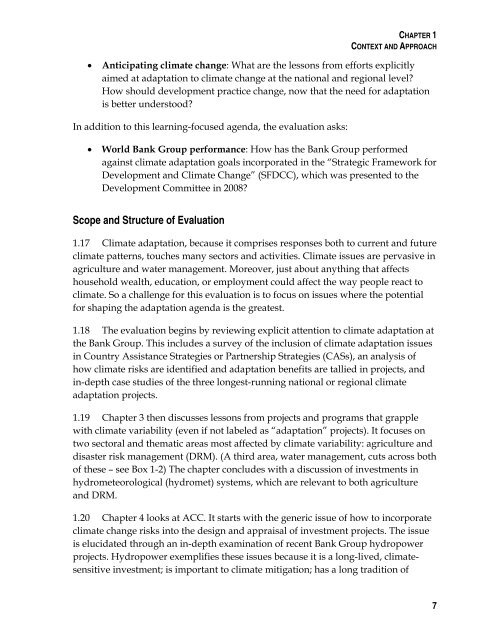Adapting to Climate Change: Assessing the World Bank Group ...
Adapting to Climate Change: Assessing the World Bank Group ...
Adapting to Climate Change: Assessing the World Bank Group ...
Create successful ePaper yourself
Turn your PDF publications into a flip-book with our unique Google optimized e-Paper software.
CHAPTER 1CONTEXT AND APPROACHAnticipating climate change: What are <strong>the</strong> lessons from efforts explicitlyaimed at adaptation <strong>to</strong> climate change at <strong>the</strong> national and regional level?How should development practice change, now that <strong>the</strong> need for adaptationis better unders<strong>to</strong>od?In addition <strong>to</strong> this learning-focused agenda, <strong>the</strong> evaluation asks:<strong>World</strong> <strong>Bank</strong> <strong>Group</strong> performance: How has <strong>the</strong> <strong>Bank</strong> <strong>Group</strong> performedagainst climate adaptation goals incorporated in <strong>the</strong> “Strategic Framework forDevelopment and <strong>Climate</strong> <strong>Change</strong>” (SFDCC), which was presented <strong>to</strong> <strong>the</strong>Development Committee in 2008?Scope and Structure of Evaluation1.17 <strong>Climate</strong> adaptation, because it comprises responses both <strong>to</strong> current and futureclimate patterns, <strong>to</strong>uches many sec<strong>to</strong>rs and activities. <strong>Climate</strong> issues are pervasive inagriculture and water management. Moreover, just about anything that affectshousehold wealth, education, or employment could affect <strong>the</strong> way people react <strong>to</strong>climate. So a challenge for this evaluation is <strong>to</strong> focus on issues where <strong>the</strong> potentialfor shaping <strong>the</strong> adaptation agenda is <strong>the</strong> greatest.1.18 The evaluation begins by reviewing explicit attention <strong>to</strong> climate adaptation at<strong>the</strong> <strong>Bank</strong> <strong>Group</strong>. This includes a survey of <strong>the</strong> inclusion of climate adaptation issuesin Country Assistance Strategies or Partnership Strategies (CASs), an analysis ofhow climate risks are identified and adaptation benefits are tallied in projects, andin-depth case studies of <strong>the</strong> three longest-running national or regional climateadaptation projects.1.19 Chapter 3 <strong>the</strong>n discusses lessons from projects and programs that grapplewith climate variability (even if not labeled as “adaptation” projects). It focuses ontwo sec<strong>to</strong>ral and <strong>the</strong>matic areas most affected by climate variability: agriculture anddisaster risk management (DRM). (A third area, water management, cuts across bothof <strong>the</strong>se – see Box 1-2) The chapter concludes with a discussion of investments inhydrometeorological (hydromet) systems, which are relevant <strong>to</strong> both agricultureand DRM.1.20 Chapter 4 looks at ACC. It starts with <strong>the</strong> generic issue of how <strong>to</strong> incorporateclimate change risks in<strong>to</strong> <strong>the</strong> design and appraisal of investment projects. The issueis elucidated through an in-depth examination of recent <strong>Bank</strong> <strong>Group</strong> hydropowerprojects. Hydropower exemplifies <strong>the</strong>se issues because it is a long-lived, climatesensitiveinvestment; is important <strong>to</strong> climate mitigation; has a long tradition of7

















